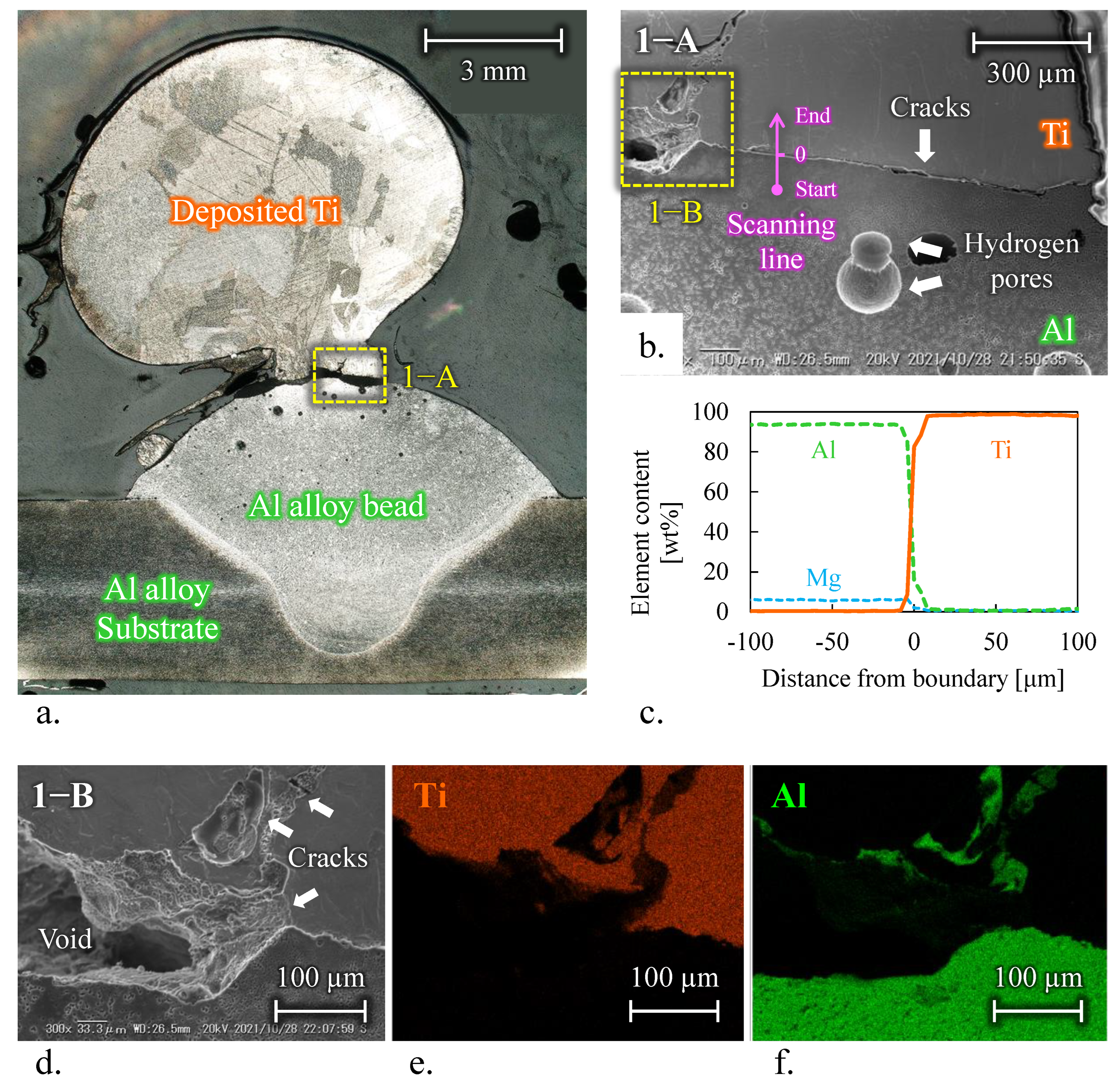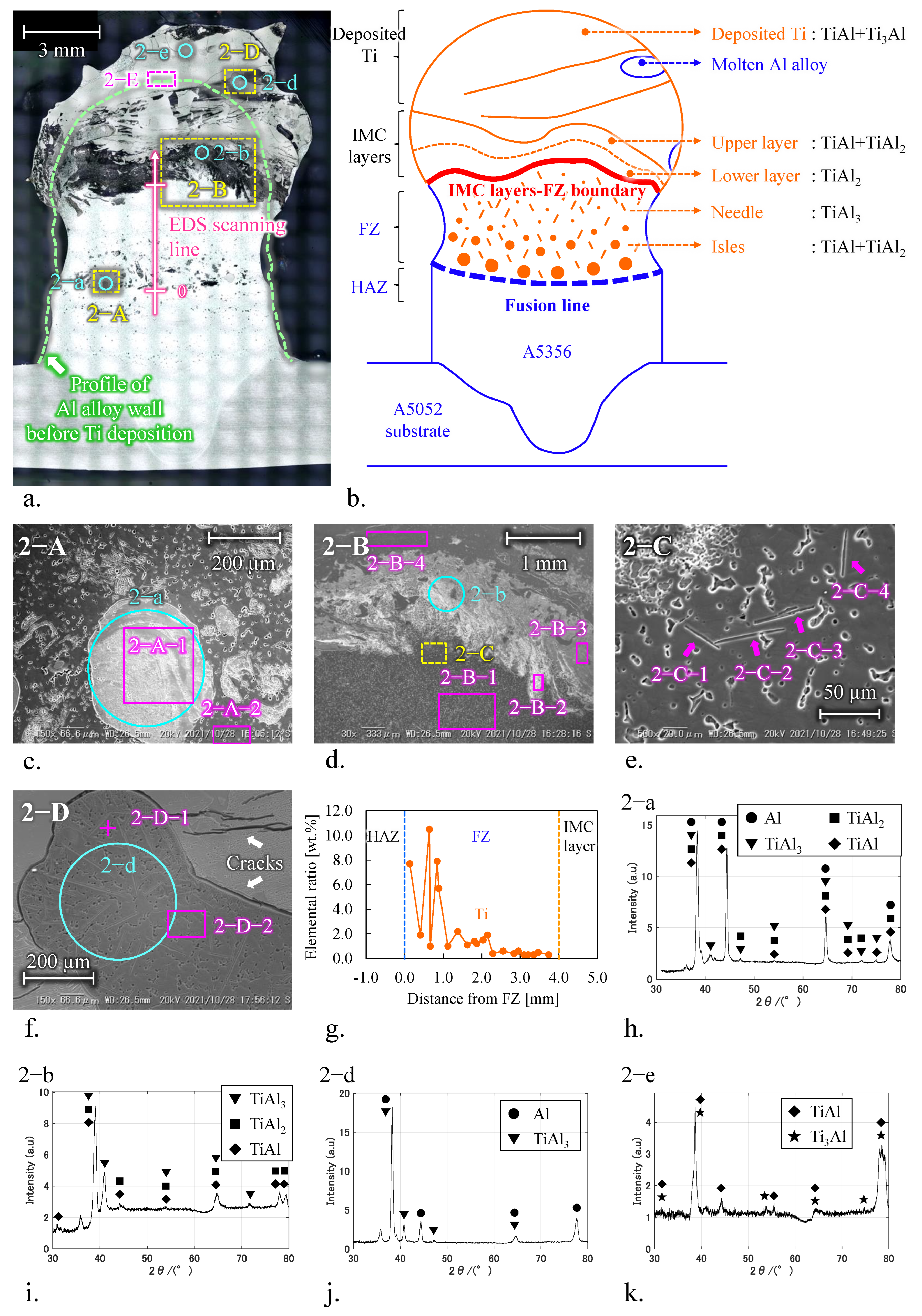Microstructure Evaluation of the Potential of Additive Manufactured Dissimilar Titanium–Aluminum Alloys
Abstract
:1. Introduction
2. Materials and Methods
3. Results and Discussions
3.1. Appearance and Joinability of Ti/Al Components
3.2. Fabrication of Pure Ti Layer Equivalent to the Used Wire on Al Alloy Component
3.3. Fabrication of Ti-Al Alloys Layer on Al Alloy Component
4. Conclusions
Author Contributions
Funding
Institutional Review Board Statement
Informed Consent Statement
Data Availability Statement
Conflicts of Interest
Appendix
| Composition Formula | Crystal System | Card No. |
|---|---|---|
| Al | Cube crystal | 03−065−2869 |
| TiAl3 | Tetragonal | 03−065−5174 |
| TiAl2 | Tetragonal | 01−072−9142 |
| TiAl | Tetragonal | 01−072−5004 |
| Ti3Al | Hexagonal | 00−052−0859 |
References
- Chen, S.; Li, L.; Chen, Y.; Dai, J.; Huang, J. Improving Interfacial Reaction Nonhomogeneity during Laser Welding–Brazing Aluminum to Titanium. Mater. Des. 2011, 32, 4408–4416. [Google Scholar] [CrossRef]
- Sahul, M.; Sahul, M.; Vyskoč, M.; Čaplovič, Ľ.; Pašák, M. Disk Laser Weld Brazing of AW5083 Aluminum Alloy with Titanium Grade 2. J. Mater. Eng. Perform. 2017, 26, 1346–1357. [Google Scholar] [CrossRef]
- Casalino, G.; Mortello, M.; Peyre, P. Yb–YAG Laser Offset Welding of AA5754 and T40 Butt Joint. J. Mater. Process. Technol. 2015, 223, 139–149. [Google Scholar] [CrossRef]
- Bang, H.S.; Bang, H.S.; Song, H.J.; Joo, S.M. Joint Properties of Dissimilar Al6061-T6 Aluminum Alloy/Ti-6%Al-4%V Titanium Alloy by Gas Tungsten Arc Welding Assisted Hybrid Friction Stir Welding. Mater. Des. 2013, 51, 544–551. [Google Scholar] [CrossRef]
- Watanabe, M.; Kumai, S. Dissimilar Metal Lap Welding of A5052 Aluminum Alloy and TP340 Pure Titanium Plates by Using Magnetic Pulse Welding. Keikinzoku Yosetsu/J. Light Met. Weld. 2020, 58 (Supplement), 91–96. [Google Scholar] [CrossRef]
- Li, J.; Sun, Q.; Liu, Y.; Cai, C.; Feng, J. Cold Metal Transfer Welding-Brazing of Pure Titanium TA2 to Aluminum Alloy 6061-T6 . Adv. Eng. Mater. 2017, 19, 1600494. [Google Scholar] [CrossRef]
- Shouzheng, W.; Yajiang, L.; Juan, W.; Kun, L.; Pengfei, Z. Microstructure and Joining Mechanism of Ti/Al Dissimilar Joint by Pulsed Gas Metal Arc Welding. Int. J. Adv. Manuf. Technol. 2014, 70, 1137–1142. [Google Scholar] [CrossRef]
- Prisco, U.; Zhang, R.; Jiang, F.; Xue, L.; Yu, J. Review of Additive Manufacturing Techniques for Large-Scale Metal Functionally Graded Materials. Crystals 2022, 12, 858. [Google Scholar] [CrossRef]
- Hasanov, S.; Alkunte, S.; Rajeshirke, M.; Gupta, A.; Huseynov, O.; Fidan, I.; Alifui-Segbaya, F.; Rennie, A. Review on Additive Manufacturing of Multi-Material Parts: Progress and Challenges. J. Manuf. Mater. Process. 2022, 6, 4. [Google Scholar] [CrossRef]
- Tian, Y.; Shen, J.; Hu, S.; Wang, Z.; Gou, J. Microstructure and Mechanical Properties of Wire and Arc Additive Manufactured Ti-6Al-4V and AlSi5 Dissimilar Alloys Using Cold Metal Transfer Welding. J. Manuf. Process. 2019, 46, 337–344. [Google Scholar] [CrossRef]
- Tian, Y.; Shen, J.; Hu, S.; Gou, J.; Kannatey-Asibu, E. Wire and Arc Additive Manufactured Ti–6Al–4V/Al–6.25Cu Dissimilar Alloys by CMT-Welding: Effect of Deposition Order on Reaction Layer. Sci. Technol. Weld. Join. 2020, 25, 73–80. [Google Scholar] [CrossRef]
- Hotz, H.; Zimmermann, M.; Greco, S.; Kirsch, B.; Aurich, J.C. Additive Manufacturing of Functionally Graded Ti-Al Structures by Laser-Based Direct Energy Deposition. J. Manuf. Process. 2021, 68, 1524–1534. [Google Scholar] [CrossRef]
- Yang, Z.; Liu, Q.; Wang, Y.; Ma, Z.; Liu, Y. Fabrication of Multi-Element Alloys by Twin Wire Arc Additive Manufacturing Combined with in-Situ Alloying. Mater. Res. Lett. 2020, 8, 477–482. [Google Scholar] [CrossRef]
- Bermingham, M.J.; Thomson-Larkins, J.; St John, D.H.; Dargusch, M.S. Sensitivity of Ti-6Al-4V Components to Oxidation during out of Chamber Wire + Arc Additive Manufacturing. J. Mater. Process. Technol. 2018, 258, 29–37. [Google Scholar] [CrossRef] [Green Version]
- Ishikawa, T.; Paradis, P.F. Thermophysical Properties of Molten Refractory Metals Measured by an Electrostatic Levitator. J. Electron. Mater. 2005, 34, 1526–1532. [Google Scholar] [CrossRef]
- Li, F.; Chen, S.; Shi, J.; Zhao, Y.; Tian, H. Thermoelectric Cooling-Aided Bead Geometry Regulation in Wire and Arc-Based Additive Manufacturing of Thin-Walled Structures. Appl. Sci. 2018, 8, 207. [Google Scholar] [CrossRef] [Green Version]
- Zhao, H.; Zhang, G.; Yin, Z.; Wu, L. A 3D Dynamic Analysis of Thermal Behavior during Single-Pass Multi-Layer Weld-Based Rapid Prototyping. J. Mater. Process. Technol. 2011, 211, 488–495. [Google Scholar] [CrossRef]
- Mathers, G. The Welding of Aluminium and Its Alloys; Elsevier: Amsterdam, The Netherlands, 2002. [Google Scholar] [CrossRef]
- Shen, H.; Lin, J.; Zhou, Z.; Liu, B. Effect of Induction Heat Treatment on Residual Stress Distribution of Components Fabricated by Wire Arc Additive Manufacturing. J. Manuf. Process. 2022, 75, 331–345. [Google Scholar] [CrossRef]
- Bai, X.; Zhang, H.; Wang, G. Modeling of the Moving Induction Heating Used as Secondary Heat Source in Weld-Based Additive Manufacturing. Int. J. Adv. Manuf. Technol. 2014, 77, 717–727. [Google Scholar] [CrossRef]
- Molina, J.M.; Voytovych, R.; Louis, E.; Eustathopoulos, N. The Surface Tension of Liquid Aluminium in High Vacuum: The Role of Surface Condition. Int. J. Adhes. Adhes. 2007, 27, 394–401. [Google Scholar] [CrossRef]
- Dal, M.; Peyre, P. Multiphysics Simulation and Experimental Investigation of Aluminum Wettability on a Titanium Substrate for Laser Welding-Brazing Process. Metals 2017, 7, 218. [Google Scholar] [CrossRef] [Green Version]
- Yin, S.; Yan, X.; Chen, C.; Jenkins, R.; Liu, M.; Lupoi, R. Hybrid Additive Manufacturing of Al-Ti6Al4V Functionally Graded Materials with Selective Laser Melting and Cold Spraying. J. Mater. Process. Technol. 2018, 255, 650–655. [Google Scholar] [CrossRef]
- Chen, C.; Xie, Y.; Yan, X.; Yin, S.; Fukanuma, H.; Huang, R.; Zhao, R.; Wang, J.; Ren, Z.; Liu, M.; et al. Effect of Hot Isostatic Pressing (HIP) on Microstructure and Mechanical Properties of Ti6Al4V Alloy Fabricated by Cold Spray Additive Manufacturing. Addit. Manuf. 2019, 27, 595–605. [Google Scholar] [CrossRef]
- Rodrigues, T.A.; Duarte, V.R.; Miranda, R.M.; Santos, T.G.; Oliveira, J.P. Ultracold-Wire and Arc Additive Manufacturing (UC-WAAM). J. Mater. Process. Technol. 2021, 296, 117196. [Google Scholar] [CrossRef]
- Dey, H.C.; Albert, S.K.; Bhaduri, A.K.; Kamachi Mudali, U. Activated Flux TIG Welding of Titanium. Weld World 2013, 57, 903–912. [Google Scholar] [CrossRef]
- Mandolini, M.; Fan, S.; Guo, X.; Tang, Y.; Guo, X. Microstructure and Mechanical Properties of Al-Cu-Mg Alloy Fabricated by Double-Wire CMT Arc Additive Manufacturing. Metals 2022, 12, 416. [Google Scholar] [CrossRef]
- Abe, T.; Mori, D.; Sonoya, K.; Nakamura, M.; Sasahara, H. Control of the Chemical Composition Distribution in Deposited Metal by Wire and Arc-Based Additive Manufacturing. Precis. Eng. 2019, 55, 231–239. [Google Scholar] [CrossRef]
- Zhang, T.; Huang, Z.; Yang, T.; Kong, H.; Luan, J.; Wang, A.; Wang, D.; Kuo, W.; Wang, Y.; Liu, C.T. In Situ Design of Advanced Titanium Alloy with Concentration Modulations by Additive Manufacturing. Science 2021, 374, 478–482. [Google Scholar] [CrossRef]





| Material | Dimension | O | H | N | C | Fe | Al | V | Ti |
|---|---|---|---|---|---|---|---|---|---|
| ERTi-2 | Wire | ≤0.15 | ≤0.008 | ≤0.02 | ≤0.03 | ≤0.20 | - | - | Bal. |
| Ti6Al4V | Plate | ≤0.20 | ≤0.015 | ≤0.05 | ≤0.08 | ≤0.30 | 5.50–6.75 | 3.50–4.50 | Bal. |
| Material | Dimension | Si | Fe | Cu | Mn | Cr | Zn | Mg | Al |
|---|---|---|---|---|---|---|---|---|---|
| ER5356 | Wire | ≤0.25 | ≤0.40 | ≤0.10 | 0.05–0.20 | 0.05–0.20 | - | 4.5–5.5 | Bal. |
| AlMg2.5 | Plate | - | ≤0.40 | ≤0.10 | ≤0.10 | 0.15–0.35 | ≤ 0.10 | - | Bal. |
| Test No. | Previous Layer | Current | Voltage | Travel Speed | Wire Feed Speed | Input Heat | Total Flow Rate Ar Gas | |
|---|---|---|---|---|---|---|---|---|
| Material | Dimension | I | U | TS | WFS | Q | ||
| - | - | A | V | mm/min | m/min | J/min | L/min | |
| 1 | Ti6Al4V | Plate | 69 | 17.3 | 50 | 3.6 | 1432 | 95 |
| 2 | 70 | 1023 | ||||||
| 3 | 100 | 716 | ||||||
| 4 | 200 | 358 | ||||||
| 5 | ER5356 | Singlebead | 69 | 17.3 | 30 | 3.6 | 2387 | 95 |
| 6 | 50 | 1432 | ||||||
| 7 | 70 | 1023 | ||||||
| 8 | 100 | 716 | ||||||
| 9 | ER5356 | Wall | 69 | 17.3 | 70 | 3.6 | 1023 | 95 |
| 10 | 69 | 17.3 | 100 | 3.6 | 716 | |||
| 11 | 90 | 18.6 | 70 | 5.5 | 1435 | |||
| 12 | 120 | 19.8 | 100 | 7.3 | 1426 | |||
| Location | Characteristic | Ti | Al | Mg | Possible Phase |
|---|---|---|---|---|---|
| 2−A−1 | Isles | 43.3 | 54.0 | 2.7 | TiAl2 + TiAl |
| 2−A−2 | Al alloy wall | 0.0 | 95.3 | 4.7 | Al |
| 2−B−1 | Al alloy wall | 0.2 | 94.1 | 5.6 | Al |
| 2−B−2 | Al alloy-side interlayer | 29.3 | 68.1 | 2.6 | TiAl2 |
| 2−B−3 | Ti-side interlayer | 41.0 | 57.2 | 1.8 | TiAl2 + TiAl |
| 2−B−4 | Ti deposited part | 51.9 | 46.4 | 1.7 | TiAl + Ti3Al |
| 2−C−1,2,3,4 | Needle | 6.6–10.7 | 84.9–89.3 | 3.7–4.8 | TiAl3 |
| 2−D−1 | Needle | 11.9 | 83.2 | 4.9 | TiAl3 |
| 2−D−2 | Molten Al alloy | 0.1 | 93.8 | 6.0 | Al |
| 2−E | Ti-deposited part | 51.3 | 46.8 | 1.9 | TiAl + Ti3Al |
Publisher’s Note: MDPI stays neutral with regard to jurisdictional claims in published maps and institutional affiliations. |
© 2022 by the authors. Licensee MDPI, Basel, Switzerland. This article is an open access article distributed under the terms and conditions of the Creative Commons Attribution (CC BY) license (https://creativecommons.org/licenses/by/4.0/).
Share and Cite
Nagamatsu, H.; Abe, T.; Sasahara, H. Microstructure Evaluation of the Potential of Additive Manufactured Dissimilar Titanium–Aluminum Alloys. Materials 2022, 15, 9038. https://doi.org/10.3390/ma15249038
Nagamatsu H, Abe T, Sasahara H. Microstructure Evaluation of the Potential of Additive Manufactured Dissimilar Titanium–Aluminum Alloys. Materials. 2022; 15(24):9038. https://doi.org/10.3390/ma15249038
Chicago/Turabian StyleNagamatsu, Hideaki, Takeyuki Abe, and Hiroyuki Sasahara. 2022. "Microstructure Evaluation of the Potential of Additive Manufactured Dissimilar Titanium–Aluminum Alloys" Materials 15, no. 24: 9038. https://doi.org/10.3390/ma15249038
APA StyleNagamatsu, H., Abe, T., & Sasahara, H. (2022). Microstructure Evaluation of the Potential of Additive Manufactured Dissimilar Titanium–Aluminum Alloys. Materials, 15(24), 9038. https://doi.org/10.3390/ma15249038









